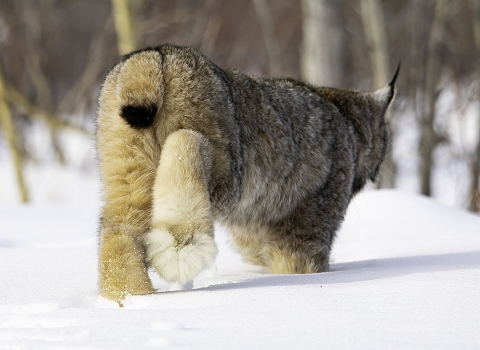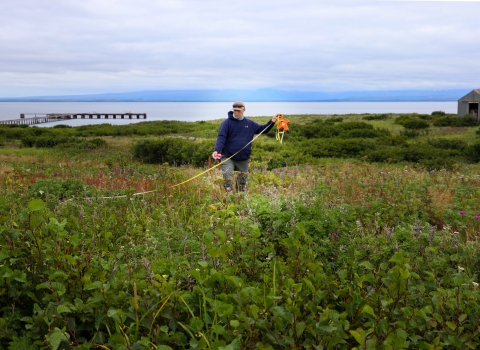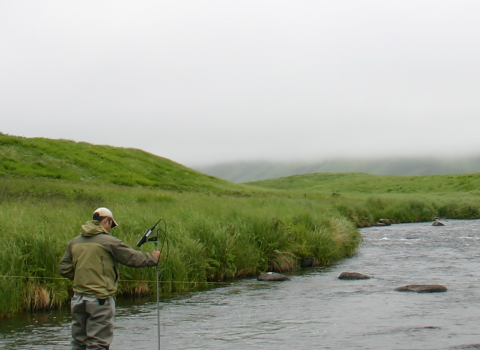Projects and Research
From collaborative projects that extend beyond the boundaries of the Refuge to long-term studies of migratory birds and everything in between, our projects help us monitor changes over time and inform management and conservation.
The Northwest Boreal Forest Lynx Project is a collaborative effort between the U.S. Fish and Wildlife Service, the University of Alaska Fairbanks, and the National Park Service to study movement patterns, dispersal behavior, and survival of lynx in relation to snowshoe hare abundance.
Canada lynx populations depend on snowshoe hare as their primary prey. Hare populations are...
Kanuti National Wildlife Refuge, the Alaska Department of Fish and Game, and the Bureau of Land Management (BLM), cooperatively conduct semi-annual, aerial moose population surveys of Kanuti Refuge and surrounding State and BLM lands in small, two-seat aircraft. We survey in early winter so that we can differentiate between cows and bulls (which haven’t dropped their antlers yet). ...
Beaver food caches are an important component of beaver ecology at northern latitudes where surface water remains frozen for months each year. Aerial surveys of these caches have been used since the 1940s to monitor beaver abundance and distribution. Kanuti refuge attempts to conduct beaver food cache surveys at 5-year intervals.
Kanuti Refuge has been a leader in the investigation of boreal-breeding shorebirds in Alaska. For example, we have collaborated with the U.S. Geological Survey on a study of the migratory movements of Kanuti-breeding Whimbrels and how they compare to North Slope-breeding Whimbrels. We also supported Master’s research on the breeding biology of Whimbrels on the Refuge.
Read more...Lesser Yellowlegs are a commonly occurring shorebird within Kanuti Refuge. In 2019 we partnered with the Alaska Migratory Birds Office to serve as a study site as part of a multi-partner investigation of migratory movements of Lesser Yellowlegs breeding at six sites across boreal Alaska and Canada. We captured and GPS-tagged 10 adult yellowlegs on the refuge and monitored their movements, with...
With the mosaic of habitats resulting from a rich fire history, an abundance of water bodies, and diverse physiographic features, Kanuti National Wildlife Refuge supports over 40 species of breeding landbirds. The refuge conducts two of these long-term surveys by boat along the Kanuti River; they are used to help monitor landbird populations on a regional (Alaska) and continental scale....
Beginning in 1968, and every five years since 1975, the U.S. Fish and Wildlife Service has been performing aerial censuses of interior Alaska's summering (presumably) Trumpeter Swan population. Kanuti Refuge has participated in the census since 1985. From 1990–2020, swan pairs in the Refuge have increased 657%. A recent supplemental nest survey suggests that 95% of Kanuti’s...
In recognition of continental declines in both scaup and scoters, Alaska Interior-wide surveys were started in 2014, including on Kanuti Refuge. The Alaska Migratory Birds Office completes annual statewide surveys in the spring for breeding pairs of dabbling ducks and other waterbirds, but because scaup and scoters are best observed later than are dabblers, a separate survey was...
Water is critically important to all the habitats and species found on Alaska’s Refuges, including Kanuti. The Water Resources Branch provides scientific leadership and technical assistance, collecting and interpreting water quantity and quality data to address water management issues and acquire water rights on Alaska’s refuges. Data collected by the Water Resources Branch are used to...
Each year we conduct an aerial line transect survey of Greater White-fronted and Canada Geese during their molting period. Concerns in the 1990s about declines in the interior and northwest Alaska-breeding populations of white-fronts (aka “mid-continent population”) sparked increased attention to this species. Similar and complementary surveys are conducted on other refuges in interior Alaska...
As part of the National Wetlands Inventory, we are mapping and digitizing high priority wetlands in Alaska’s 16 National Wildlife Refuges.
The U.S. Fish and Wildlife Service is the principal federal agency tasked with providing public information on the status and trends of our Nation's wetlands. Our National Wetlands Inventory provides detailed information...
Invasive Species Program staff collaborate with Alaska's National Wildlife Refuge, the State of Alaska and other partners to protect Alaska's lands and waters by working to detect invasive species infestations while they’re still relatively small and have the highest chance of being successfully eradicated. We survey terrestrial, freshwater, and marine environments for invasive plants and...
Water is critically important to all the habitats and species found on Alaska’s Refuges. The Water Resources Branch provides scientific leadership and technical assistance, collecting and interpreting water quantity and quality data to address water management issues and acquire water rights on Alaska’s refuges. Data collected by the Water Resources Branch are used to quantify ecological water...







